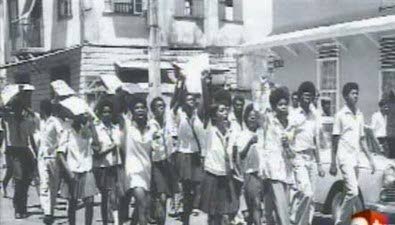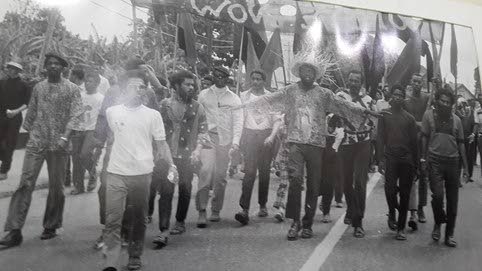Black Power Revolution 1970 – a cry for people power, unity

EMBAU MOHENI
Servant President of NJAC
TODAY, April 21, marks the 51st anniversary of the declaration of the first State of Emergency (SOE) during the Trinidad and Tobago Revolution of 1970.
This revolution, also referred to as the Black Power Revolution of 1970 was led by the National Joint Action Committee (NJAC), under the visionary leadership of the late chief servant Makandal Daaga (then Geddes Granger), for a new and just society in TT.
The events of this day were preceded by a series of mass demonstrations which included the well-known March to Caroni on March 12, 1970, when thousands of people from the urban communities in north Trinidad marched to central Trinidad in solidarity with their East Indian brothers and sisters.
The cry was for “people’s power” and “national unity.” There was a return march planned for that day (April 21), from Central Trinidad to Port of Spain. The Government, on getting wind of this plan, declared a state of emergency and detained most of the NJAC leadership. The government was very determined to stop the Indians from marching into Port of Spain at all costs.
The impression is sometimes given that the state of emergency was imposed to stop violence that was developing in the demonstrations. What must be made very clear is that the demonstrations were extremely disciplined. For example, after all the predictions of violence on the march to Caroni, it was highly disciplined and very peaceful from beginning to end. The newspapers reported that this massive demonstration engaging some 40,000 people was incident free. (Trinidad Guardian of March 13, 1970).
It is a fact, however, that Special Branch police officers were used to start the violence in demonstrations in Port of Spain to provide an excuse to attack NJAC. In this regard, George Alleyne’s article in the Newsday of January 4, 1999 is very instructive. Following, is an extract from it:
“Black Power leaders had staged a march of several thousands down Charlotte Street. But unknown to them there were agents provocateurs from the Special Branch, who marched alongside them shouting Black Power slogans.
“As the demonstrations neared the Charlotte Street/Independence Square (North) intersection the agent provocateurs reportedly, ran into a couple of the Charlotte stores and began tossing goods from the shelves. They were quickly followed by demonstrators, who did immense damage as had been the plan.

“The agents provocateurs immediately ran out of the stores and moments later police officers began firing tear gas at the demonstrators. This happened on Thursday, April 16, 1970. A few days later the state of emergency was declared.”
The Special Branch incited the violence, framed the movement, and gave the Government the excuse they wanted. The Prime Minister made a statement to the effect that he was for Black Power when it stood for black dignity, but when it involves violence and the destruction of private property it could not be tolerated. Shortly afterwards a State of Emergency was declared.
With the declaration of the SOE on April 21, 1970, the chief servant Makandal Daaga and other members of the NJAC leadership, were detained on Nelson Island and at the Royal Jail, Port of Spain. In the ensuing months, a reign of terror was released on the population. A dusk to dawn curfew was imposed, from which several people suffered detention, often with physical brutality.
On the morning of April 21, a number of Defence Force soldiers, under the leadership of lieutenants Raffique Shah and Rex Lassalle, mutinied and took control of Teteron Barracks. One soldier, Clyde Bailey, lost his life when the soldiers came under shelling from the Coast Guard in their attempt to leave Teteron.
A number of soldiers were later tried and found guilty of mutiny, with Shah being sentenced to 20 years in prison, Lassalle 15 years and Michael Bazie seven years. Other soldiers got lesser sentences.
Students Demonstrate for Freedom of the Soldiers in 1971
The position taken by the soldiers however, won widespread support and they were renamed the “People’s Army.” The students took the lead, in holding demonstrations calling for the release of the soldiers, with Woodbrook Secondary playing a prominent part in the march on Port of Spain. In Tobago, the students of the Roxborough Composite School also marched in support of the soldiers. Other students, primarily from Bishop's High School, joined them and together they marched on Scarborough.
The soldiers appealed their sentences which they won in the Appeal Court, but the Government appealed to the Privy Council. The Privy Council however, upheld the soldiers’ appeal and they were released on July 27 and 28, 1972. A massive crowd gathered outside the Royal Jail to welcome them to freedom after more than two years’ incarceration. It was certainly a victory for the people and a demonstration of people’s power. It was a lesson in revolutionary politics. NJAC re-defined politics, from that of an elitist experience and practice, to that of a life source, with the people firmly rooted as the heartbeat of the entire process.
The movement’s main instrument, the street demonstration, served two main functions. Firstly, it was used to convey the people’s demands and their determination to achieve them. Secondly, the demonstration gave NJAC the ideal opportunity it needed to launch a nationwide education initiative. The demonstration itself was transformed into a massive school. Along the length of a single demonstration, there could be as many as six PA systems at strategic intervals, with six speakers discussing a variety of topics at the same time. Speakers dealt with such topics as politics, the economy, history, philosophy, race relations, the family, the woman and the youth, Caribbean relations or any topic which could enlighten the people.
The revolution also spurned the rise of a host of young leaders with a commitment to “make the necessary sacrifices now and not leave the burden to the next generation.”
As we reflect on this momentous and most defining period in our nation’s history, let us strive to build a society based on the principles of brotherhood and sisterhood which united and strengthened our communities in the 1970s.


Comments
"Black Power Revolution 1970 – a cry for people power, unity"